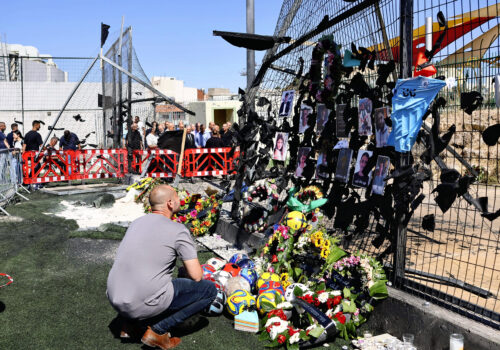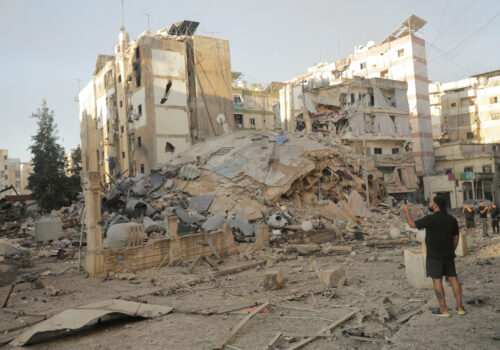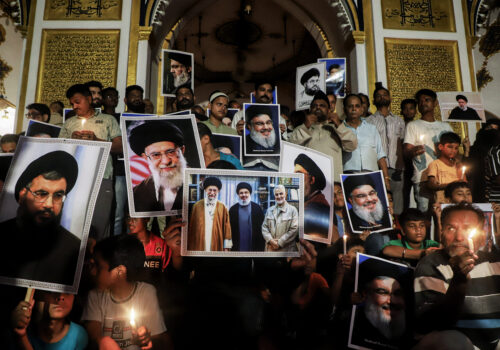Israel versus Hezbollah: Not a full-scale war—yet
In 1982, up to six divisions of the Israeli army charged into Lebanon to drive out the Palestine Liberation Organization (PLO). They reached the outskirts of Beirut in nine days, launching a two-month siege of the Lebanese capital that ended with the departure of the PLO. In the 2006 war against Hezbollah, Israel anticipated that airpower alone would defeat its Iran-backed enemy in south Lebanon and stem the flow of rockets into Israeli territory. But after two weeks and no respite from the rocket fire, at least five brigades and three reservist divisions were deployed to Israel’s northern border. There, Israel launched a series of faltering incursions into south Lebanon, where the ill-prepared Israeli soldiers encountered a well-trained, well-equipped, well-armed Hezbollah operating from a network of tunnels and bunkers.
On October 1 of this year, Israeli troops returned to south Lebanon for the first time in eighteen years—the latest phase in a year-long conflict that has escalated steadily over this past month. This time, however, the Israeli army appears to have absorbed some of the lessons of its troubled 2006 experience fighting against Hezbollah.
SIGN UP FOR THIS WEEK IN THE MIDEAST NEWSLETTER
Four divisions have been mobilized for what the Israeli military says are “limited, localized, and targeted ground raids” in south Lebanon. The first troops across the border were drawn from the Ninety-First Galilee Division’s elite units, the Golani Reconnaissance Brigade and the Egoz commandos, which were established in 1995 specifically to fight Hezbollah. The intention appears to be to locate and destroy Hezbollah’s military infrastructure close to the Blue Line, the United Nations’ term for the boundary running along Lebanon’s southern border. Israel says Hezbollah could use these positions to attack vulnerable Israeli communities in the north. Israel hopes that the operation will allow for the return of the more than 60,000 residents of northern Israel who evacuated their homes months ago because of the threat posed by Hezbollah rocket fire. So far, Israeli troops have uncovered several bunkers and tunnels, captured at least four Hezbollah fighters, and dynamited civilian structures in border villages, including an entire neighborhood in the village of Mohaibib. Nevertheless, it does not appear that the Israelis are physically occupying any of the incursion points for any length of time. The ground operations more closely resemble in-and-out raids rather than an invasion and occupation and, so far, are limited to a depth of around three kilometers.
As of this writing, the Israelis appear to be operating at six locations in Lebanon close to the border:
- Labboune is an unpopulated, brush-covered hillside that lies just southeast of Naqoura, a coastal village where the headquarters of the United Nations Interim Force in Lebanon (UNIFIL) are located. Hezbollah had a visible military presence on the hillside before the outbreak of hostilities in October 2023, including several observation posts linked to Hezbollah’s environmental non-governmental organization, Green Without Borders. The Blue Line follows an escarpment at Labboune that offers sweeping southward views to the coastal town of Nahariyeh and, beyond that, to Haifa, Israel’s third-largest city.
- Ramieh-Aitta Shaab-Qawzah is a triangle of villages that reportedly saw fierce clashes on October 13, October 14, and again on October 16. Five Israeli soldiers from the Golani Reconnaissance Brigade were killed in this sector during a Hezbollah ambush on October 17.
- Yaroun-Maroun er Ras-Aitteroun is a three-kilometer axis a few hundred meters from the Blue Line. Hezbollah also had a military presence in the area, particularly on a hill overlooking the border south of Aitteroun.
- Blida-Mohaibib-Meiss al Jabal-Markaba is a stretch of the border that runs north to south for about ten kilometers, some of which overlooks the flat plain of northern Galilee to the east. Israeli troops have made several probes toward these villages and have been attacked by Hezbollah fighters armed with rockets, anti-tank missiles, and mortar rounds.
- Addaisseh-Kfar Kila is a narrow chokepoint where the Blue Line lies only three kilometers from the Litani River. The main road hugs the Blue Line between these two villages.
- Kfar Shuba is a Sunni-populated village on the edge of the Shebaa Farms, a rugged mountainside claimed by Lebanon that has been occupied by Israel since 1967. Israeli soldiers from the Mountain Brigade have reportedly carried out raids against Hezbollah infrastructure in this area.
Hezbollah has suffered a series of powerful blows in the past month, including the September 27 assassination of its veteran secretary-general, Hassan Nasrallah, in a massive air strike on what Israel said was the group’s underground command headquarters in the southern suburbs of Beirut. Several other senior leaders and top commanders have been killed and wounded since mid-September, demonstrating that Israeli intelligence seems to have thoroughly penetrated Hezbollah, an organization once known for its tight internal security. On September 23, Israel launched a widescale aerial bombing campaign against what the Israeli military said were Hezbollah infrastructure sites, claiming to have struck 1,600 targets in the first day. Nearly 500 people in Lebanon were killed in the first twenty-four hours of the raids.
Israel has warned the residents of dozens of villages and towns in southern Lebanon to leave their homes and move north of the Awali River, which lies some fifty-five kilometers from the border. UNIFIL sources say that the airstrikes against Hezbollah’s rocket launchers in the south appear to have been effective. One officer said that the peacekeepers have seen numerous destroyed launchers, some loaded with unfired rockets and others soaked in blood, presumably from the operators.
Despite its leadership having been badly mauled, Hezbollah’s surviving officials remain defiant. Naim Qassem, now Hezbollah’s acting secretary-general, said in a televised speech on October 7 that “the longer the war continues, the more difficult impasse Israel will face.”
He added, “We are striking the enemy and expanding the range of fire. We will reach any place at the time we decide according to our plan. We are steadfast, and we will emerge victorious.” Reports have claimed that Qassem has since left Lebanon for Iran to avoid being assassinated.
Indeed, in the first twenty-four hours of ground operations, eight Israeli soldiers were killed and more than thirty wounded in separate clashes. Six of the soldiers died when an Egoz commando unit was ambushed by Hezbollah fighters, believed to be drawn from its elite Radwan Brigade, in the border village of Addaisseh.
Hezbollah has greatly increased the number of operations it carries out each day, according to the group’s statements. Most of the attacks use stand-off munitions such as mortar rounds and anti-tank missiles to target Israeli troop movements along the Blue Line. Some of the attacks hit what Hezbollah says are Israeli troop gatherings in towns set some distance from the Blue Line, which suggests that despite Israeli ground incursions, Hezbollah retains good reconnaissance capabilities, perhaps by employing drones or having a physical presence within eyeshot of the targets. Hezbollah has staged several ambushes against Israeli soldiers using improvised explosive devices and close-quarter small-arms fire.
So far, Hezbollah has relied mainly on its arsenal of relatively short-range, unguided surface-to-surface rockets to pound areas of northern Israel. However, Hezbollah announced on October 17 that it intended to “transition to a new and escalating phase in the confrontation with the Israeli enemy,” a possible indicator that it might employ precision-guided missiles on a more regular tactical basis. Indeed, before the announcement, Hezbollah sent warning shots to Israel by firing four precision-guided ballistic missiles in three separate sorties, a reminder that the group has the capacity to inflict far greater damage on Israel. Two missiles, Qader-1 and Qader-2, were fired on separate occasions toward the Tel Aviv area. A pair of Nasr-1 missiles were launched at an Israeli army barracks site east of Netanya on October 16. Since the announcement, Hezbollah has fired several volleys of what it calls “precision missiles” at targets in and around Haifa and Netanya. Nevertheless, Hezbollah’s increased use of precision-guided missiles over the past week falls well short of the mass barrages one might expect to see in a full-scale war. By the same token, Hezbollah has not used its arsenal of anti-ship missiles, and its air defense systems have been limited to challenging Israeli unmanned aerial vehicles (UAVs) in Lebanese airspace. Hezbollah shot down three UAVs last week—two Hermes 450s and one Hermes 900—bringing the total to eight UAVs shot down since hostilities began a year ago. Some Israeli officials claim that half of Hezbollah’s precision-guided systems have been destroyed in multiple air strikes and that the wave of assassinations of top political and military leaders may have damaged Hezbollah’s command and control system. It is impossible to judge the accuracy of such claims.
Nevertheless, Hezbollah is a structured organization that should have the capacity to replace slain commanders with equally capable deputies relatively quickly. Israeli military intelligence has reportedly noted that Hezbollah forces on the front lines remain disciplined and maintain a “strict military hierarchy.” Hezbollah units on the ground are given a great deal of autonomy to confront Israeli forces. They know the mission and can proceed without having to remain in constant contact with the chain of command. The fighters tend to operate in the areas where they live, so they are intimately familiar with the terrain. There are probably only a few hundred fighters deployed along the six main axes of confrontation who have contact with Israeli ground forces. Other fighters will be deployed in villages and underground positions further north, awaiting the Israeli forces should they advance deeper into Lebanon.
For now, Hezbollah’s use of mainly unguided rockets is sufficient to prevent the Israeli government from sending Israeli evacuees back to their homes in the north, its primary war goal. Furthermore, Hezbollah and Israel are not yet engaged in a full-scale war, although it may look like it. Unlike the 2006 war, civilian state infrastructure has not been deliberately targeted to date. In 2006, Beirut’s airport was put out of action on the very first day, and bridges and roads were destroyed across Lebanon. Hezbollah may resort to more advanced missile systems in greater numbers and frequency if the war escalates to targeting infrastructure. It is in Hezbollah’s nature to act incrementally when confronting the Israeli military, reserving some of its more advanced weaponry for when it is needed and to retain the element of surprise. If Israel escalates, Hezbollah needs to be able to match that escalation. Hezbollah’s more advanced missiles could also form part of Iran’s counter-retaliation to the long-anticipated Israeli retaliation to Iran’s mass rocket barrage of Israel at the beginning of the month. The continued threat posed by Hezbollah’s existing arsenal was amply demonstrated when four Israeli soldiers were killed and more than sixty were wounded on October 13, following a Hezbollah drone strike on a dining hall in the Golani Brigade’s training base in Binyamina, midway between Haifa and Netanya and some fifty-five kilometers south of the Lebanese border. In another striking incident, a drone launched from Lebanon evaded air defense assets to strike the Caesarea home of Israeli Prime Minister Benjamin Netanyahu. Netanyahu was not at home at the time. Curiously, Hezbollah did not claim responsibility for the drone attack.
While Israel appears to have had some tactical on-the-ground success in south Lebanon, its strategic goal—beyond returning the displaced Israelis to their homes in the north—is still unclear. Israel reportedly intends to prevent Radwan fighters from entering villages and designate the area immediately adjacent to the border fence on the Lebanese side of the Blue Line as off-limits to all civilians. There have been several reports of Israeli troops dynamiting houses and even neighborhoods in border villages in a possible bid to make them uninhabitable for a long period of time. Israel reportedly demands the ability to enforce the no-entry zone to the extent of opening fire on anyone the army considers a combatant. It is hard to imagine Hezbollah, let alone the Lebanese government, agreeing to such terms, regardless of how heavily Israel bludgeons the group. Yielding to such terms would be tantamount to total defeat for Hezbollah, undermining the group’s self-stated raison d’être as a “resistance” force defending Lebanon and casting doubt about the future durability of the group.
From Hezbollah’s perspective, despite the pounding it receives, the group has the benefit of time. Assuming it can weather the blows from the daily torrent of air strikes, all Hezbollah needs to do is maintain the flow of rockets into northern Israel and confront Israeli troop movements on the ground. Doing so will deny Israel the ability to return the evacuees to their homes. At some point, Netanyahu may have to decide whether to move toward a negotiated solution or escalate the conflict even further, perhaps by going after Lebanese infrastructure. If he opts for the latter, the current conflict will worsen considerably.
Nicholas Blanford is a nonresident senior fellow with the Atlantic Council’s Middle East Programs.
Further reading
Wed, Oct 9, 2024
The countdown to Nasrallah’s assassination began with Majdal Shams
MENASource By David Daoud
Hezbollah Secretary-General Hassan Nasrallah signed his death warrant on July 27.
Fri, Oct 4, 2024
Israel has lost its patience
MENASource By Nicholas Blanford
Since September 16, Israel has removed the gloves to stage a massive aerial bombing campaign targeting Hezbollah’s top political and military leadership and weapons sites to force the Iran-backed group to yield and redeploy its forces away from Lebanon’s southern border.
Tue, Oct 1, 2024
Hezbollah c’est moi: The Party of God without Hassan Nasrallah
MENASource By David Daoud
The person and the position became synonymous.
Image: Aroldo Lázaro, Head of Mission and Force Commander of the United Nations Interim Force in Lebanon (UNIFIL) in South Lebanon, visited peacekeepers in two Irish positions, which have seen intense fighting nearby on Oct 202, 2024. United Nations peacekeepers in Lebanon have said the Israeli army deliberately damaged one of their positions in southern Lebanon, in the latest incident reported by the force that remains deployed in all of its positions. via Reuters



